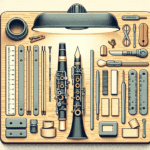The quality and adjustment of reeds are key factors in achieving the best sound on your clarinet. Various clarinet reed adjustment tools allow musicians to customize their reeds for optimal performance. This article covers the essential tools every clarinetist should consider for reed adjustment.
The Importance of Reed Adjustments
Proper reed adjustments ensure your instrument plays in tune, produces the desired tone, and responds well to different dynamics. The reed's shape, thickness, and cut all play significant roles in sound quality. By using the right tools, you can tailor your reeds to complement your unique playing style.
Types of Reed Adjustment Tools
1. Reed Cutters: High-quality reed cutters enable precise cuts on the tip and sides of the reed, which is crucial for managing the reed's strength and flexibility.
2. Files: Sandpaper and diamond files help shape the vamp and adjust the reed's thickness. Different grit options allow for precise adjustments without risking over-sanding.
3. Reed Adjusting Jigs: These devices securely hold the reed during adjustments, promoting uniformity and precision in shaping.
4. Thickness Gauges: These tools are vital for measuring reed thickness, ensuring consistency in tone and timbre.
5. Adjustable Reed Clamp: These clamps hold the reed steady for precise adjustments, particularly useful for delicate work.
| Tool | Primary Function | Skill Level |
|---|---|---|
| Reed Cutter | Precise tip and side cuts | Intermediate to Advanced |
| Files | Shaping and thickness adjustment | Beginner to Advanced |
| Reed Adjusting Jig | Secure reed holding | Intermediate |
| Thickness Gauge | Measuring reed thickness | All Levels |
| Adjustable Reed Clamp | Steady reed holding for precise work | Intermediate to Advanced |
Choosing the Right Tools
When selecting reed adjustment tools, keep these factors in mind:
- Quality: Opt for durable, high-quality tools. Lower-quality options might lead to poor adjustments and frustration.
- Variety: A diverse toolkit helps address various issues. For example, having files with different grits offers more flexibility.
- Comfort: Select tools that feel natural in your hands. This will make adjustments easier and reduce strain over time.
How to Use Reed Adjustment Tools Effectively
While reed adjustment may seem challenging at first, practice and proper techniques can yield excellent results:
Using a Reed Cutter
Begin with minor adjustments when cutting a reed. Carefully position the cutter to get the right angle and depth. Always measure your cuts to avoid removing excess material.
Working with Files
Use even pressure with sandpaper or diamond files to prevent uneven surfaces. File in a direction that matches the reed's natural slant. Test the reed after each adjustment to check its response.
Using a Reed Jig
Secure your reed firmly in the jig. Use your files or cutters to adjust the reed while it's held in place, which can significantly improve accuracy.
Measuring Thickness
When using thickness gauges, measure multiple points on the reed to ensure uniformity. A consistent thickness across the reed will improve its responsiveness.
The Value of Patience
Allow ample time for reed adjustments. Rushing can lead to hasty decisions, while patience often results in better outcomes.
Common Mistakes and How to Avoid Them
Even seasoned players can make errors in reed adjustment. Here are some common pitfalls and how to sidestep them:
- Over-sanding: It's easy to remove too much material, compromising the reed's integrity. Always proceed with caution.
- Neglecting Tests: Always test the reed's performance after adjustments to identify any issues requiring further attention.
- Using Worn Tools: Dull files or cutters can result in uneven adjustments. Keep your tools well-maintained.
- Skipping Documentation: Many professionals log their reed adjustments. This practice helps track which changes produce the best results.
Conclusion
Perfecting reed adjustment is key for any clarinetist looking to improve their sound. Using the right tools and techniques will enhance your playing, resulting in a richer tone and more enjoyable performance experience. With consistent practice and dedication, you can master reed adjustment, elevating both your clarinet skills and your passion for music.







